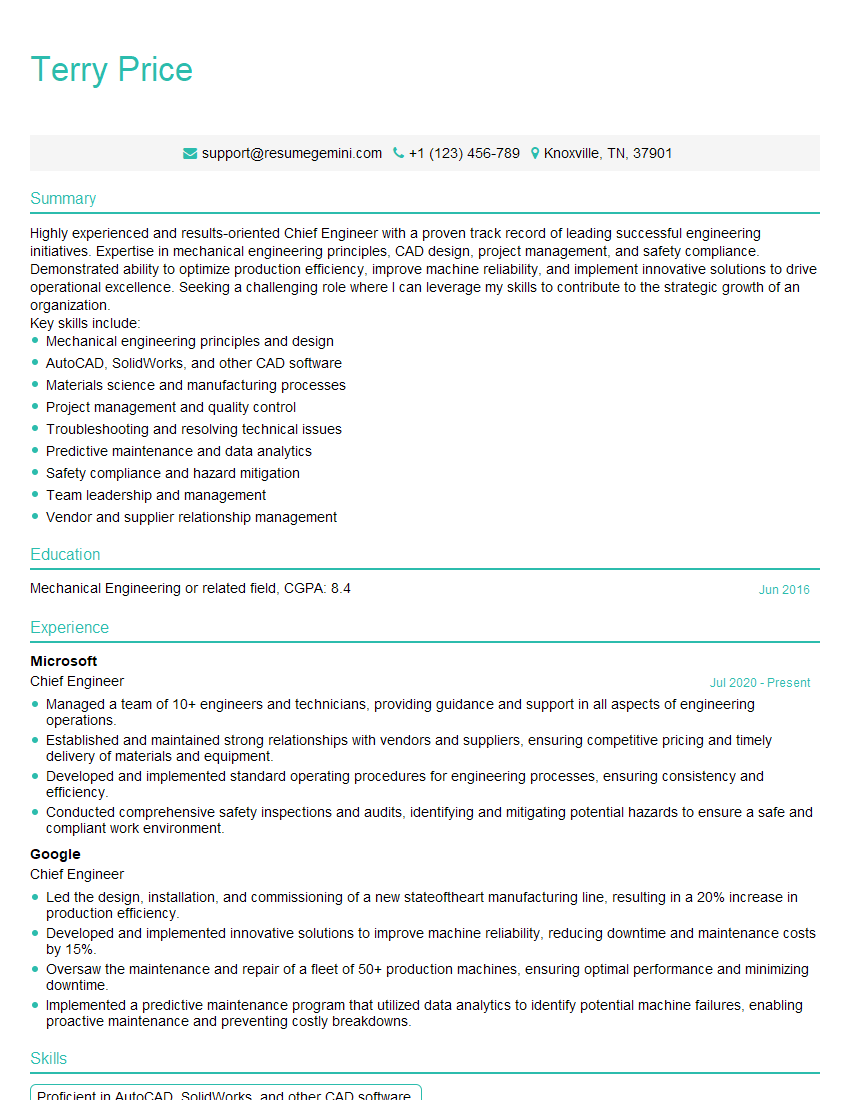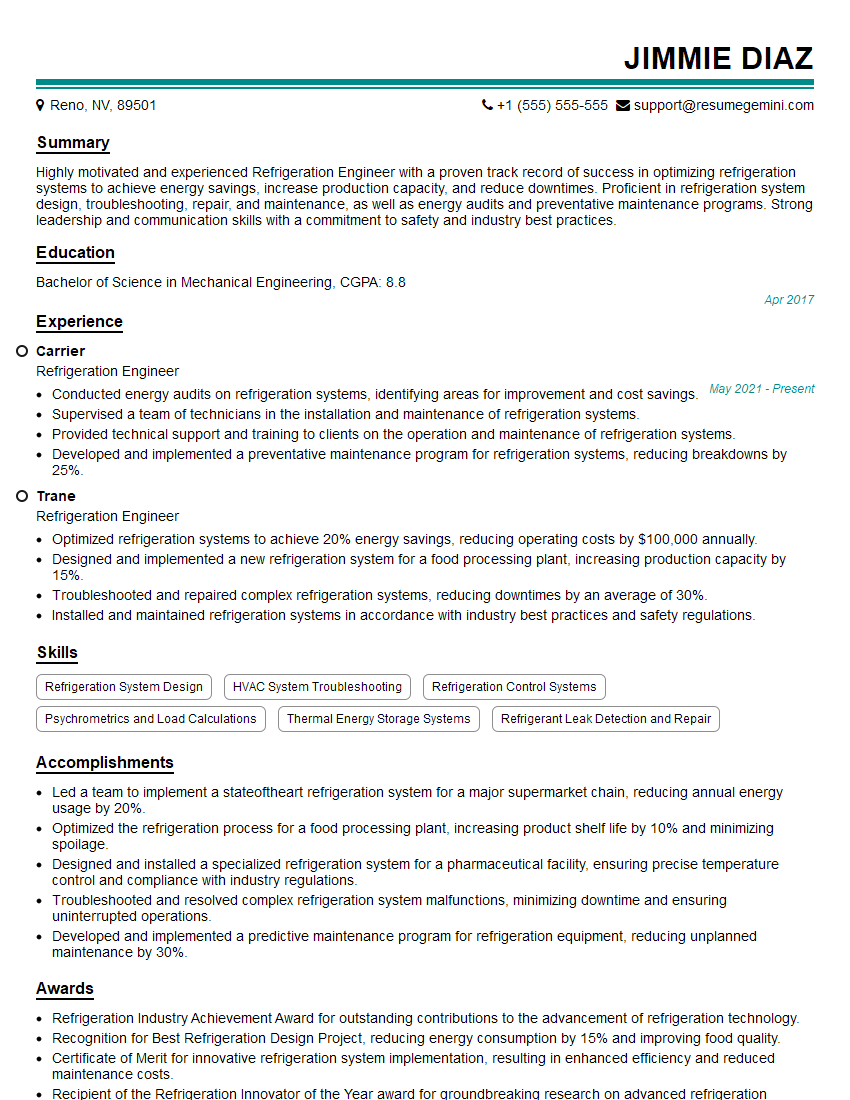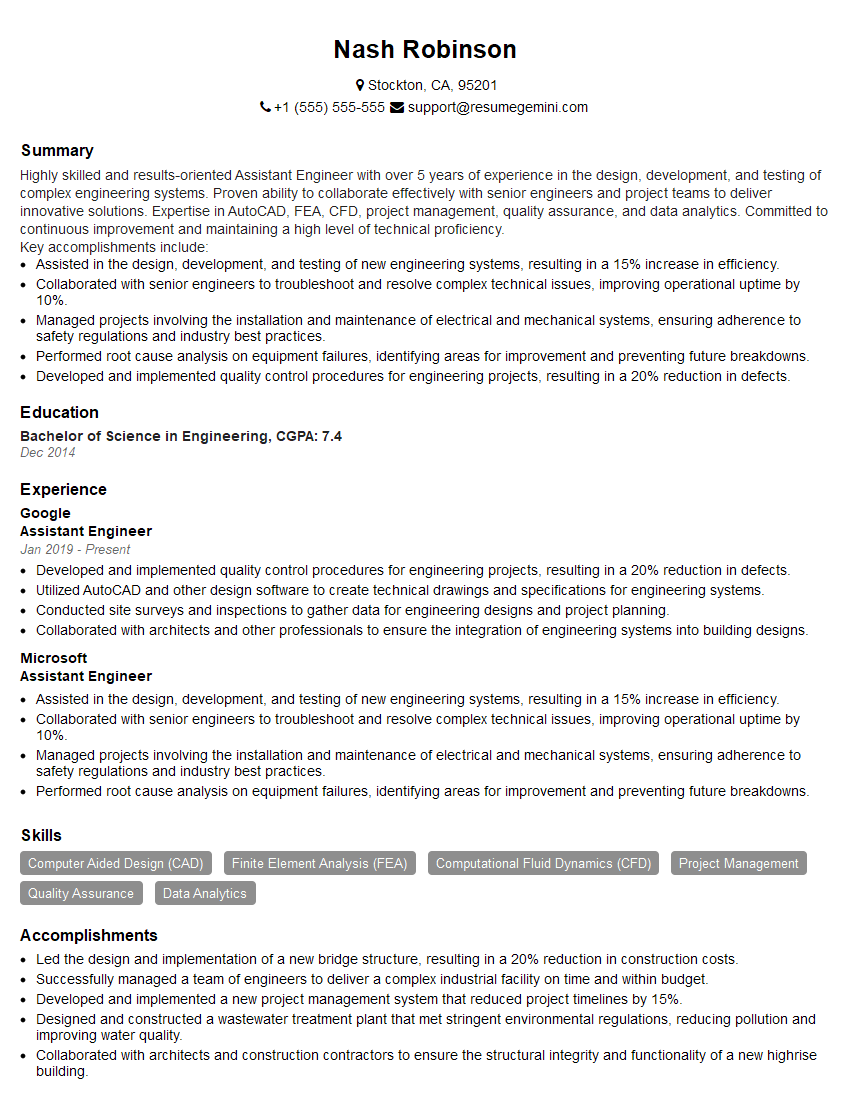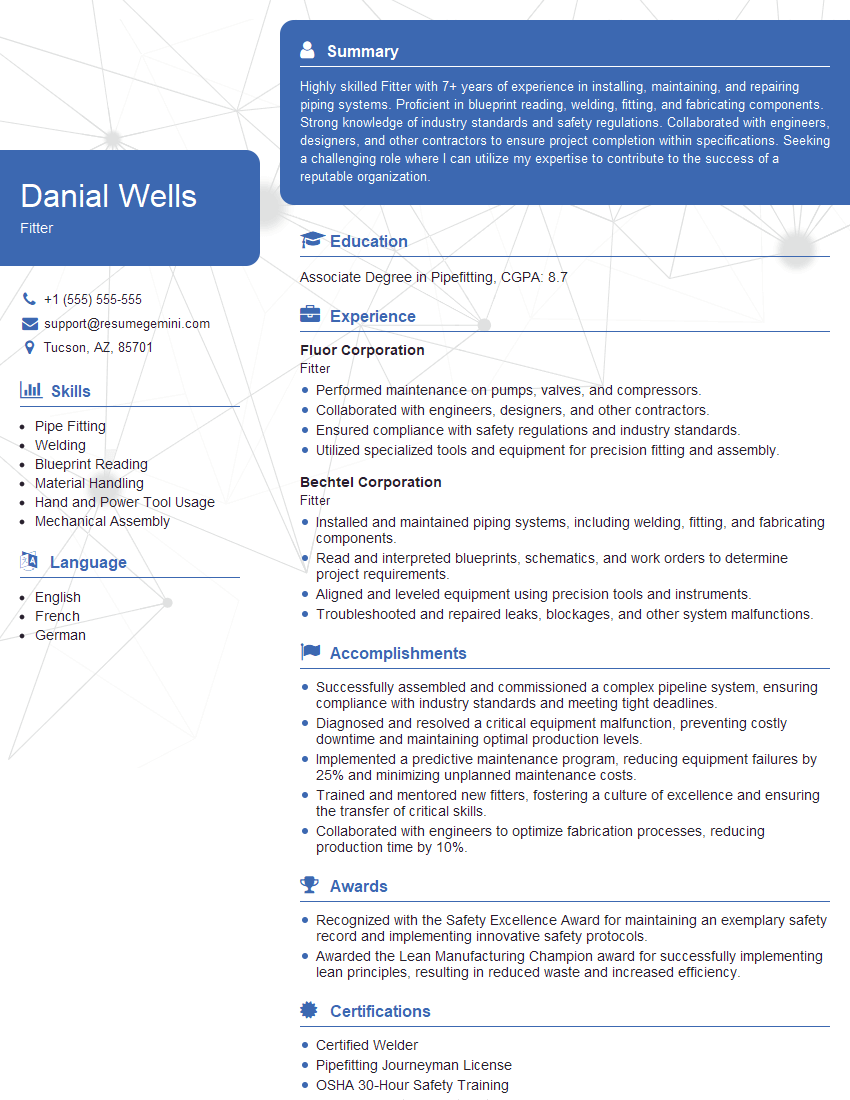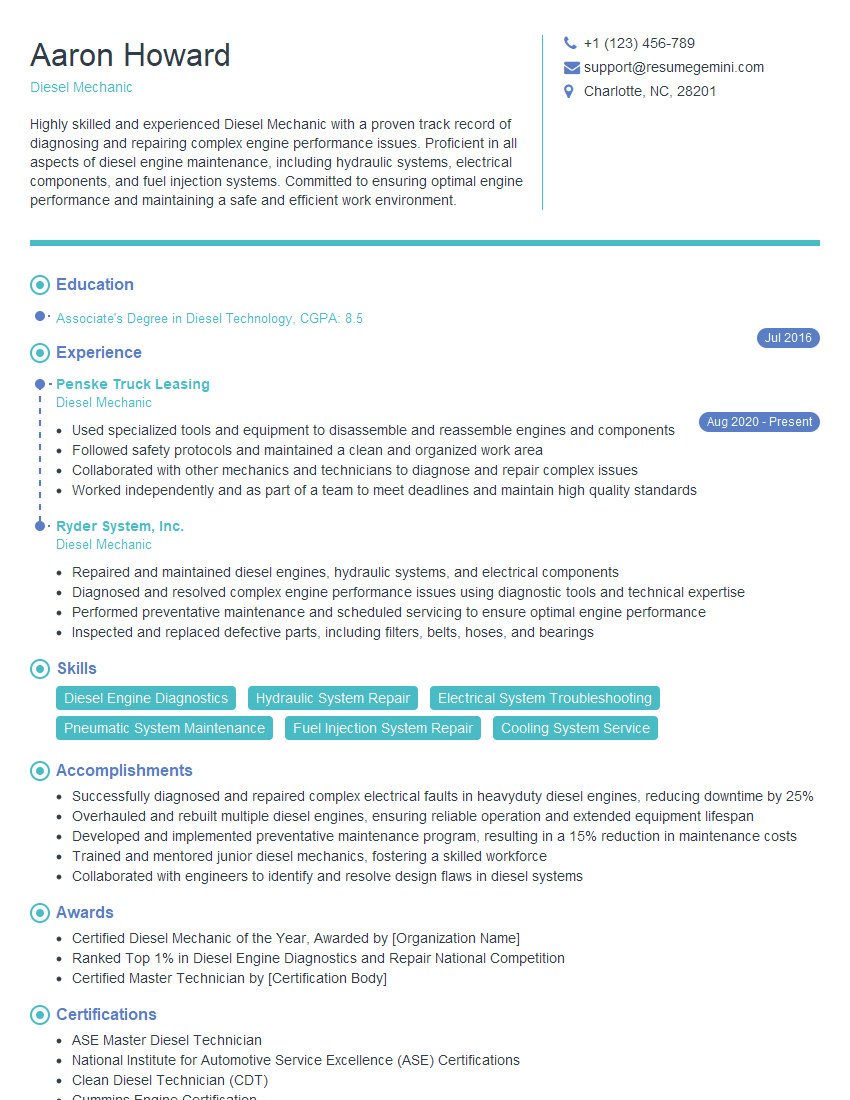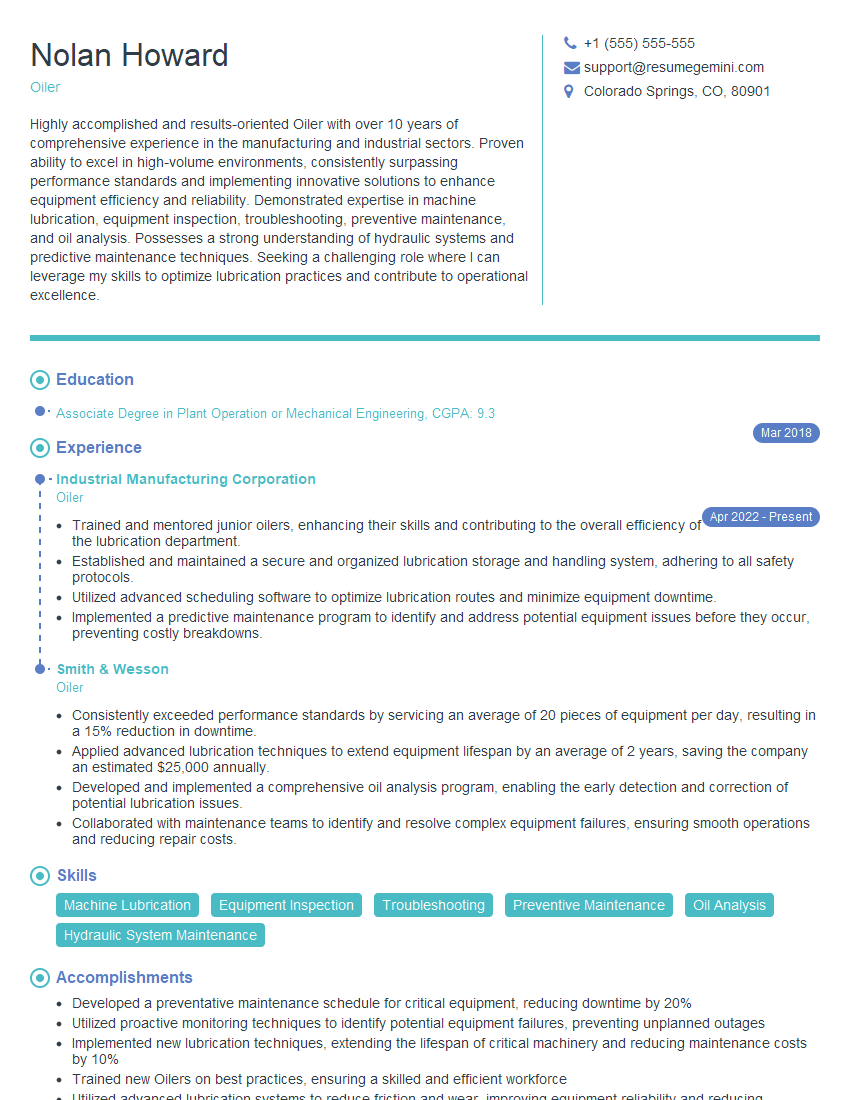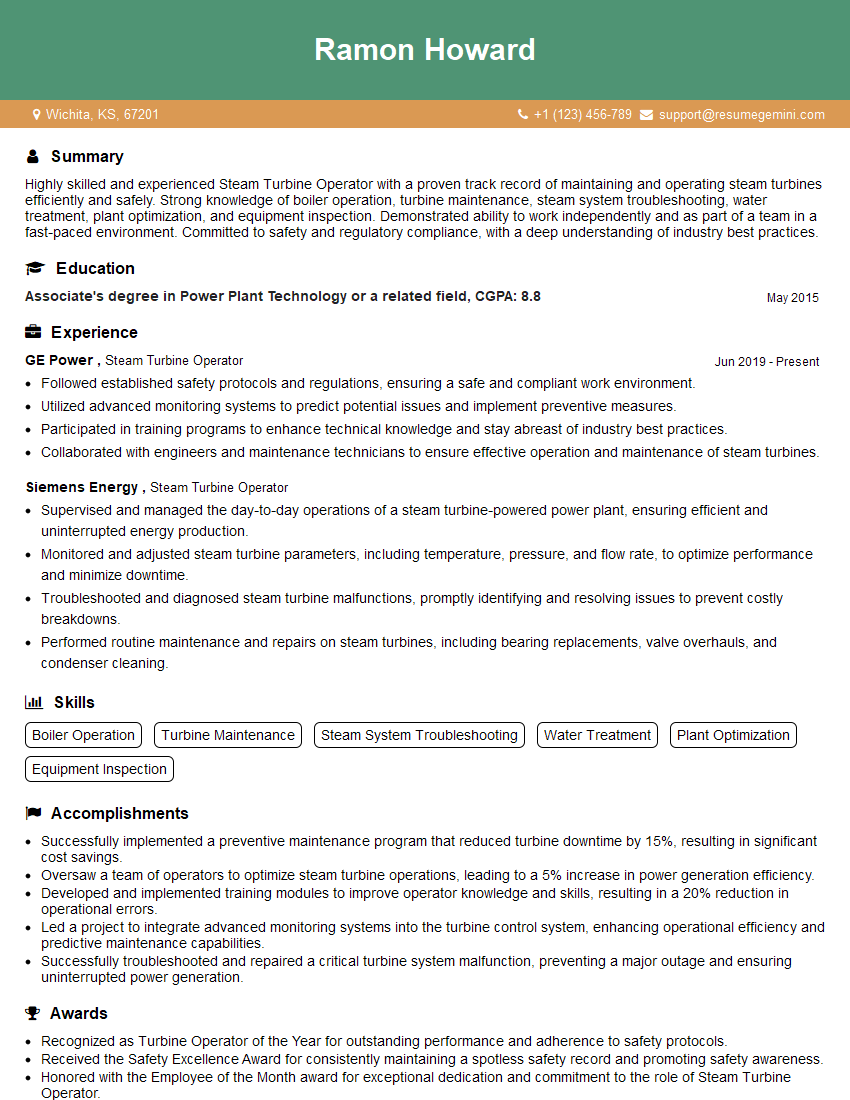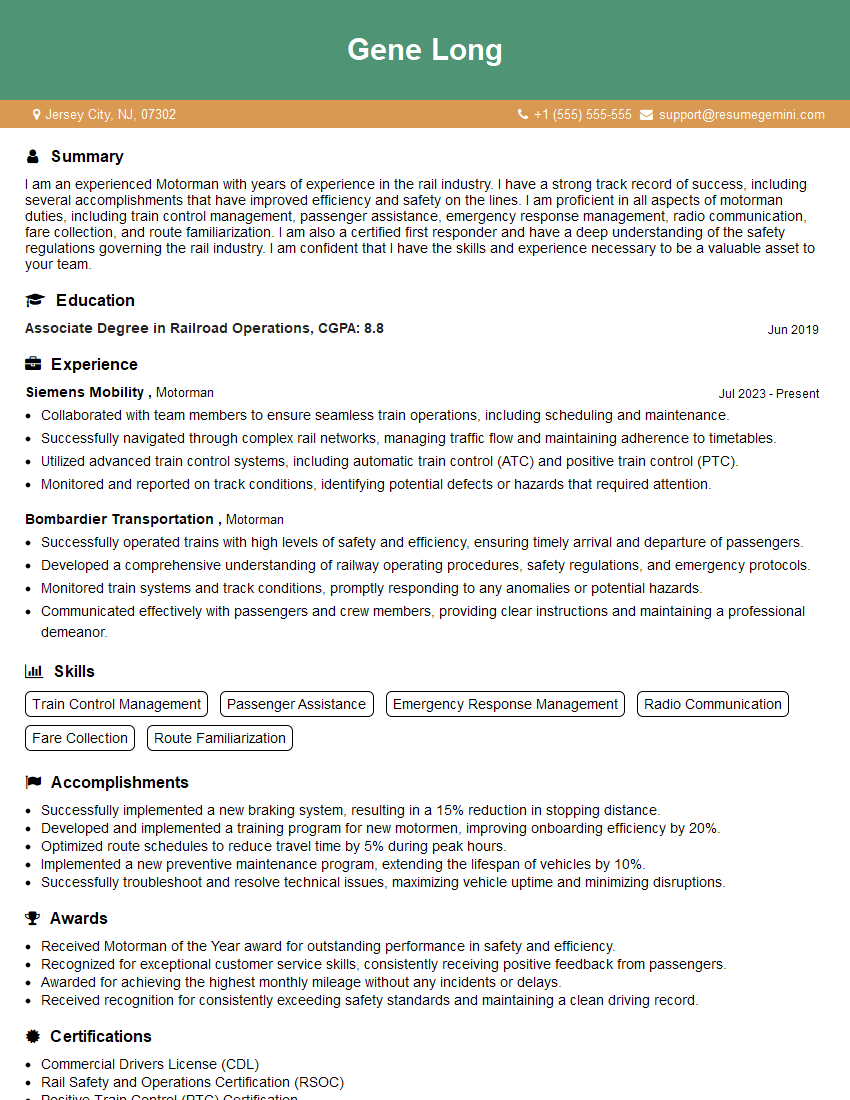Are you ready to stand out in your next interview? Understanding and preparing for Shipboard machinery operations interview questions is a game-changer. In this blog, we’ve compiled key questions and expert advice to help you showcase your skills with confidence and precision. Let’s get started on your journey to acing the interview.
Questions Asked in Shipboard machinery operations Interview
Q 1. Describe your experience with main engine maintenance procedures.
Main engine maintenance is crucial for a ship’s operational safety and efficiency. My experience encompasses a wide range of procedures, from daily checks to major overhauls. Daily routines include monitoring vital parameters like oil pressure, temperature, and fuel consumption, ensuring everything operates within specified limits. I’ve been involved in scheduled maintenance tasks like cylinder lubrication system cleaning, fuel injector servicing, and turbocharger inspections. This includes disassembling, cleaning, inspecting, and reassembling components, ensuring they meet manufacturer specifications. I have also participated in more extensive overhauls, involving the complete dismantling and rebuilding of specific engine parts, using specialized tools and following strict procedures. A key aspect is meticulous record-keeping, documenting all maintenance activities, observations, and any necessary repairs, which is essential for predictive maintenance and troubleshooting.
For example, during a recent voyage, we detected a slight increase in cylinder liner wear. We meticulously documented this, triggering an earlier-than-scheduled inspection. This proactive approach prevented a potential major breakdown later in the voyage.
Q 2. Explain the process of troubleshooting a malfunctioning boiler.
Troubleshooting a malfunctioning boiler involves a systematic approach. The first step is to identify the symptoms: Is there insufficient steam pressure, is there a water leak, or is there unusual noise or vibration? This helps narrow down the potential causes. Next, I’d consult the boiler’s operational manual and systematically check safety devices, such as pressure relief valves and low water level alarms, ensuring they are functioning correctly. I would then inspect the fuel supply system, checking for proper fuel pressure, atomization, and combustion efficiency. Water level and quality are crucial; examining these parameters, including checking for leaks, scaling, and corrosion, is paramount.
For instance, if low steam pressure is the issue, I would first check the fuel supply and then check water levels and quality. If the water level is low, the cause could be a leak or a faulty feedwater pump. If the water quality is poor, it might lead to scaling and reduced boiler efficiency. Addressing these issues step by step, using diagnostic tools and leveraging my experience, would pinpoint the exact problem and guide the solution.
Q 3. How do you perform a safety check on a centrifugal pump?
A centrifugal pump safety check is a multi-step process prioritizing personnel safety and equipment integrity. I begin by visually inspecting the pump and its surroundings for any leaks, cracks, or damage to the casing, piping, and associated equipment. I then check the pump’s foundation for stability, looking for cracks or signs of movement. Before starting the pump, I check the lubrication system, ensuring adequate oil levels and pressure. Next, I’d verify that all guarding and safety devices are in place and functioning correctly. Once the pump is started, I carefully monitor vibration levels, temperature rise, and flow rate, comparing them to established norms. High vibration or abnormal temperature could indicate a problem with bearings or alignment. I also check the pressure gauges to ensure they are within acceptable ranges. Finally, after the pump is shut down, I carry out another visual inspection to confirm there are no leaks or damage.
For example, on a recent vessel, I noticed a slight vibration during a routine safety check. I immediately reduced the pump’s load and investigated. It turned out to be a slightly loose coupling, a minor issue that, if overlooked, could have led to a major failure. The early detection through careful inspection prevented downtime and potential damage.
Q 4. What are the common causes of engine overheating, and how do you address them?
Engine overheating is a serious concern, often resulting from several factors. Insufficient cooling water flow is a major culprit; blockages in the cooling system, leaks, or a malfunctioning cooling water pump can lead to overheating. Another cause is insufficient lubrication. Inadequate oil level, poor oil quality, or a malfunctioning lubrication system will lead to increased friction and heat generation. Scale buildup in the cooling system restricts water flow, and faulty or clogged air filters can limit efficient combustion. Finally, a problem with the engine itself, such as faulty piston rings or a malfunctioning cooling system, can also cause overheating.
Addressing these requires a systematic approach. If insufficient cooling water is the issue, the cooling system needs a thorough inspection and cleaning. If lubrication is inadequate, the oil level and quality must be checked, and the lubrication system must be serviced. Scale buildup needs to be removed. Addressing these problems promptly using appropriate tools and procedures and employing preventive maintenance strategies can effectively prevent engine overheating and potential damage.
Q 5. Explain the principles of lubrication in shipboard machinery.
Lubrication in shipboard machinery is vital to minimize friction, reduce wear, prevent corrosion, and enhance efficiency. The principles are based on selecting the appropriate lubricant (oil or grease) with the correct viscosity for the operating temperature and load conditions of the machinery. Proper lubrication involves ensuring a consistent supply of the lubricant to all moving parts, including bearings, gears, and cylinders. The system must be designed to effectively distribute lubricant while maintaining adequate pressure and flow. Regular oil analysis is essential to detect wear particles, contaminants, and degradation of the lubricant, enabling early identification of potential problems. Furthermore, proper filtration removes contaminants, prolonging the lifespan of the lubricants and machinery.
Think of it like oiling a bicycle chain. Without proper lubrication, the chain would wear out quickly, making the bike difficult to pedal. Similarly, shipboard machinery requires meticulous lubrication to ensure smooth operation and a longer lifespan.
Q 6. Describe your experience with fuel oil purification systems.
My experience with fuel oil purification systems includes routine operation, maintenance, and troubleshooting. These systems are crucial for removing contaminants from fuel oil, ensuring efficient combustion and preventing damage to the main engine. My tasks involve monitoring the purifier’s performance, checking parameters such as water content, sediment level, and oil temperature. I’m adept at troubleshooting issues such as inefficient separation, high water content in the purified oil, and proper operation of the centrifuge. Routine maintenance includes replacing wear parts like rings, clarifying the disc stack, and performing thorough cleaning of the equipment. Proper operation of these systems is vital for maintaining the cleanliness of the fuel, which directly impacts engine performance and longevity.
For example, during a voyage, we experienced higher than usual water content in the purified fuel oil. By systematically checking the operation of the purifier and the centrifuge, we discovered a slight misalignment that was causing less-than-optimal separation. Adjusting the alignment quickly resolved the problem.
Q 7. How do you diagnose and rectify problems with the ship’s electrical systems?
Diagnosing and rectifying problems with a ship’s electrical systems requires a thorough understanding of electrical principles, safety procedures, and troubleshooting techniques. I start by identifying the symptoms of the problem. Is there a complete power failure, a malfunctioning component, or a fluctuating voltage? Once the problem is identified, I carefully isolate the affected circuit using appropriate lockout/tagout procedures, ensuring the safety of myself and others. Using multimeters and other diagnostic tools, I systematically check for faults in wiring, connections, circuit breakers, and other components. Understanding electrical schematics is crucial for tracing the flow of electricity and identifying potential fault points. I’m proficient in using specialized testing equipment to diagnose problems in various electrical systems including lighting, power distribution, and communication systems. Safety is paramount in electrical work; following strict safety protocols is non-negotiable.
For instance, if a certain section of lights fails, I will check the circuit breaker and the wiring associated with that section. Using a multimeter, I’ll test the voltage and continuity. If the fault lies with a particular light fitting, I will replace it, following proper procedures. If the fault is more complex and requires specialist knowledge, I will escalate this to a qualified electrical engineer.
Q 8. Explain your understanding of air compressor operation and maintenance.
Air compressors are vital for providing compressed air to various systems on a ship, from starting the main engines to operating pneumatic tools. Understanding their operation and maintenance is crucial for safe and efficient ship operation.
Operation: Most shipboard compressors are reciprocating or screw type. Reciprocating compressors use pistons to compress air, while screw compressors use rotating screws. Both types draw in atmospheric air, compress it, and then store it in a receiver tank. A pressure switch controls the compressor’s operation, turning it on when pressure drops below a set point and off when it reaches the maximum pressure. Safety valves are integral to prevent over-pressurization.
Maintenance: Routine maintenance involves regular oil changes (following manufacturer’s recommendations), filter replacements (air intake, oil, and aftercooler), and visual inspections for leaks, corrosion, or damage. Pressure switch calibration and safety valve testing are also vital. Regular monitoring of air pressure, oil level, and temperature is crucial for early detection of potential problems. A well-maintained compressor ensures reliable operation and prevents costly downtime.
Example: During my time on the MV Ocean Voyager, we implemented a preventative maintenance schedule for the main air compressor that included weekly oil level checks, monthly filter changes, and quarterly safety valve testing. This proactive approach significantly reduced the risk of compressor failure and ensured a consistent supply of compressed air.
Q 9. What are the safety precautions you take when working with high-pressure systems?
Working with high-pressure systems demands stringent safety precautions. The potential for serious injury from uncontrolled release of energy is significant. My approach is based on a systematic and cautious methodology:
- Personal Protective Equipment (PPE): Always wear appropriate PPE including safety glasses, gloves, and hearing protection. For very high pressures, specialized protective clothing might be necessary.
- Lockout/Tagout Procedures: Before any maintenance or repair work, I meticulously follow lockout/tagout procedures to isolate the system from power sources and prevent accidental activation. This is a non-negotiable safety protocol.
- Pressure Relief Devices: Ensure all pressure relief valves are functioning correctly and are regularly inspected and tested. They are the last line of defense against over-pressurization.
- Leak Detection: Regularly inspect all high-pressure lines and fittings for leaks using soapy water or electronic leak detectors. Even small leaks can escalate rapidly.
- Proper Training and Certification: I ensure that I am properly trained and certified to work with high-pressure systems before undertaking any tasks.
- Emergency Procedures: I’m thoroughly familiar with emergency procedures in case of a pressure system failure, including the location and use of emergency shut-off valves and communication protocols.
Example: On one occasion, while servicing a hydraulic system, I discovered a small leak. I immediately implemented lockout/tagout, repaired the leak, and pressure tested the system before resuming operation, preventing a potentially dangerous situation.
Q 10. How do you handle emergencies, such as engine room fires or flooding?
Emergency response is paramount in the engine room. My training emphasizes rapid, effective action based on established procedures and teamwork.
Engine Room Fire: The immediate response is to raise the alarm, contain the fire using the appropriate fire-fighting equipment (CO2, foam, dry powder), and evacuate personnel to a safe location. The ship’s fire plan dictates specific actions, including shutting down affected systems and closing fire doors. Communication with the bridge is crucial to coordinate the overall ship response.
Flooding: In case of flooding, the primary focus is damage control. This involves identifying the source of the leak, activating bilge pumps to remove water, and using temporary patching materials to control further ingress. If the flooding is severe, emergency procedures may require transferring fuel or cargo to stabilize the vessel.
General Emergency Response: Regardless of the nature of the emergency, my actions are guided by the principles of safety, damage control, and effective communication. I’m well-versed in the ship’s emergency procedures, know the location of emergency equipment, and understand my responsibilities within the emergency response team.
Example: During a simulated fire drill on the MV Global Trader, my quick actions in locating and deploying the CO2 system, followed by efficiently coordinating with the fire team, resulted in a successful containment of the simulated blaze. This showcased the importance of thorough training and practiced response protocols.
Q 11. Explain your knowledge of various types of shipboard pumps.
Shipboard pumps are diverse, each designed for specific tasks. They can be broadly categorized as follows:
- Centrifugal Pumps: These are the most common type, using a rotating impeller to increase fluid velocity and pressure. They are used for bilge pumping, ballast water transfer, and general service applications. Subtypes include single-stage and multi-stage pumps.
- Reciprocating Pumps: These use pistons or plungers to displace fluid. They are suitable for high-pressure applications, such as fire pumps or hydraulic systems. They provide a more consistent flow rate than centrifugal pumps but are less efficient at higher flow rates.
- Rotary Pumps: These use rotating elements to move fluid, including gear pumps, screw pumps, and lobe pumps. They are often used for viscous fluids or those containing solids.
- Ejector Pumps: These use high-pressure steam or air to create a vacuum, drawing fluid into a discharge pipe. They are commonly used for emergency bilge pumping.
Maintenance: Routine maintenance involves regular inspection for leaks, wear and tear, and vibration. Lubrication is critical for many pump types. Balancing and alignment checks are essential, particularly for centrifugal pumps. Regular performance testing ensures that the pumps meet the required capacity and pressure.
Example: I’ve extensively worked with centrifugal pumps for ballast water management. Regular monitoring of vibration levels and ensuring proper alignment have been critical to prevent premature bearing failure and maintain optimal efficiency.
Q 12. Describe your experience with sewage treatment plants onboard vessels.
My experience with shipboard sewage treatment plants (STPs) includes operation, maintenance, and troubleshooting. Modern STPs typically employ a combination of physical, chemical, and biological processes to treat sewage before discharge into the sea, adhering to MARPOL regulations.
Typical Processes: A common STP setup might include:
- Grinders: To reduce solids size.
- Primary Clarifiers: For the removal of larger solids through settling.
- Biological Treatment: Using bacteria to break down organic matter. This might involve activated sludge or other processes.
- Secondary Clarifiers: To separate treated effluent from sludge.
- Disinfection: To kill pathogens, often using UV treatment or chlorination.
Maintenance: Regular maintenance includes cleaning of tanks, screens, and pumps; monitoring of pH and other water quality parameters; and regular inspections of equipment for wear and tear. The sludge needs regular disposal according to regulations.
Troubleshooting: Troubleshooting involves diagnosing problems such as blockages, pump failures, or inefficiencies in the biological treatment process. This requires a good understanding of the STP’s workings and the ability to interpret the data from the monitoring system.
Example: While on the MV Pacific Star, I addressed a blockage in the grinder, which was affecting the entire STP. Through careful inspection and prompt action, I resolved the blockage preventing a costly repair and ensuring compliance with environmental regulations.
Q 13. What are the different types of bearings used in ship machinery, and how are they maintained?
Ship machinery relies on various types of bearings for smooth operation and longevity. The choice depends on factors such as load, speed, and operating environment.
- Plain Bearings (Sleeve Bearings): These consist of a journal rotating within a bearing sleeve. They are simple and relatively inexpensive but are suitable for lower speeds and moderate loads. Maintenance involves lubrication and periodic inspection for wear.
- Rolling Element Bearings (Ball and Roller Bearings): These use balls or rollers to reduce friction. They can handle higher speeds and loads than plain bearings. Maintenance includes lubrication (grease or oil), checking for play, and monitoring temperature. Regular inspection for damage or wear is essential.
- Thrust Bearings: These are designed to accommodate axial loads, preventing axial movement of rotating shafts. They can be either plain or rolling element type.
Maintenance: Bearing maintenance is crucial for preventing failures and ensuring efficient operation. This includes:
- Regular Lubrication: Following the manufacturer’s recommendations for type and frequency.
- Vibration Monitoring: To detect early signs of bearing wear or damage.
- Temperature Monitoring: High temperatures indicate potential problems.
- Visual Inspection: Regular checks for signs of wear, damage, or corrosion.
- Periodic Replacement: Bearings have a finite lifespan and should be replaced according to a preventative maintenance schedule.
Example: On the MV Atlantic Express, we implemented a vibration monitoring system for main engine bearings. Early detection of increased vibration levels allowed for timely intervention, preventing a major breakdown and significant downtime.
Q 14. How do you perform a routine inspection of a diesel engine?
A routine diesel engine inspection involves a thorough visual check, operational tests, and data analysis. The goal is to identify potential problems before they become major issues.
Visual Inspection: This includes:
- External Check: Inspecting for leaks (oil, fuel, coolant), corrosion, loose connections, and any signs of damage.
- Checking Oil and Fuel Levels: Ensuring they are within the acceptable range.
- Checking Coolant Levels and Temperature: Monitoring for leaks or overheating.
- Exhaust Inspection: Checking for excessive smoke or unusual odors.
- Seawater System Inspection: Checking for any issues like leaks or blockages.
Operational Tests: This involves:
- Starting and Running: Observe engine performance, noting any unusual noises or vibrations.
- Load Testing: Gradually increasing engine load to check performance at different operating conditions.
- Checking Cylinder Pressure: Ensuring that each cylinder is operating correctly.
Data Analysis: Reviewing engine parameters recorded by the engine monitoring system, such as:
- Oil Pressure and Temperature: Looking for anomalies that could indicate problems.
- Fuel Consumption: Tracking fuel efficiency and identifying any unexpected increases.
- Exhaust Gas Temperature: Identifying potential issues with combustion.
Logbook Entries: Detailed and accurate logbook entries are crucial to track maintenance activities and identify trends.
Example: During a routine inspection, I noted a slight increase in the exhaust gas temperature of one cylinder. This led to a more detailed investigation, which revealed a minor problem with the fuel injector. Early detection prevented major damage and potential downtime.
Q 15. Explain the process of aligning a diesel engine.
Aligning a diesel engine is crucial for optimal performance and longevity. Misalignment leads to increased vibration, premature wear, and potential catastrophic failure. The process involves ensuring that the crankshaft, propeller shaft, and other rotating components are precisely aligned to minimize stress and friction. Think of it like perfectly aligning two perfectly round train wheels – if they’re even slightly off, the ride will be bumpy and inefficient.
The alignment process typically uses dial indicators or laser alignment tools. It usually involves several steps:
- Preparation: This includes cleaning the mating surfaces and ensuring all couplings and bearings are properly seated and free of obstructions.
- Initial Alignment: This usually involves rough alignment using shims or other adjustment mechanisms to bring the shafts within a certain tolerance.
- Fine Alignment: Using dial indicators, the alignment is refined by measuring the distance between the shafts at multiple points. Shims are added or removed as needed to minimize the runout.
- Verification: The alignment is verified by checking the measurements at different points and ensuring they fall within the manufacturer’s specified tolerances. Laser alignment systems provide a more accurate and efficient way of performing the fine alignment and verification.
Different types of engines may have slightly different procedures, but the overall goal remains the same – to achieve perfect concentricity between the shafts.
Career Expert Tips:
- Ace those interviews! Prepare effectively by reviewing the Top 50 Most Common Interview Questions on ResumeGemini.
- Navigate your job search with confidence! Explore a wide range of Career Tips on ResumeGemini. Learn about common challenges and recommendations to overcome them.
- Craft the perfect resume! Master the Art of Resume Writing with ResumeGemini’s guide. Showcase your unique qualifications and achievements effectively.
- Don’t miss out on holiday savings! Build your dream resume with ResumeGemini’s ATS optimized templates.
Q 16. What is your experience with different types of propulsion systems?
Throughout my career, I’ve worked extensively with various propulsion systems, including diesel-electric, gas turbine, and conventional diesel engine systems. I’ve had hands-on experience with medium-speed and high-speed diesel engines, from smaller vessels to large container ships. My experience with diesel-electric systems includes managing the generator sets and their integration with the propulsion motors, which is a delicate balance requiring significant understanding of electrical and mechanical systems. Gas turbine systems, with their high power-to-weight ratio, require a deep understanding of their specific operational parameters and maintenance protocols.
For instance, on a recent project involving a diesel-electric vessel, I was instrumental in troubleshooting a problem with generator synchronization, identifying a faulty control module that was causing erratic voltage fluctuations. My background in both mechanical and electrical systems allowed me to quickly diagnose and resolve the issue, preventing a potential shutdown and ensuring the vessel’s continued operation.
Q 17. Describe your experience with hydraulic systems onboard vessels.
My experience with hydraulic systems onboard vessels encompasses a broad range of applications, from steering gears and deck machinery to cargo handling systems and engine room auxiliaries. I’m proficient in troubleshooting and maintaining various hydraulic components, including pumps, motors, valves, and cylinders. Understanding hydraulic schematics and interpreting pressure readings is vital for efficient operation and maintenance. I’m familiar with various hydraulic fluids and their properties, including their viscosity and compatibility with different system components.
For example, I once resolved a significant problem with a vessel’s steering gear by identifying a leak in a high-pressure hydraulic line. Using pressure gauges and visual inspection, I pinpointed the location of the leak and replaced the damaged section of the line. Quick action avoided a potential collision.
Q 18. How do you troubleshoot and repair hydraulic leaks?
Troubleshooting and repairing hydraulic leaks requires a systematic approach, combining careful observation and diagnostic testing. The first step is to identify the source of the leak. This often involves visually inspecting the system for wetness, listening for hissing sounds, and checking for pressure drops. Once the location is identified, the next step involves determining the cause. Leaks can be caused by damaged seals, hoses, fittings, or even cracks in the components themselves.
Repairing the leak can involve various techniques depending on the severity and location. Minor leaks in hoses might be repairable with clamps or sealant, while more significant leaks may require replacing the damaged component. It’s essential to follow all safety procedures, including depressurizing the system before any repairs. I always use proper safety equipment like gloves and eye protection.
For example, I recently repaired a leak in a hydraulic cylinder on a crane. After isolating the section, I replaced the faulty seal, and rigorously tested the system to ensure the repair held.
Q 19. Explain your knowledge of pneumatic systems used in shipboard operations.
Pneumatic systems on ships are commonly used for various applications, including control systems, starting air for engines, and various other automated systems. These systems use compressed air to provide power and control to actuators, valves, and other components. My experience includes troubleshooting and maintenance of air compressors, air dryers, air filters, and pneumatic control valves. Understanding the principles of pneumatics, including pressure regulation, flow control, and actuation, is crucial for effective operation and maintenance.
A key aspect of working with pneumatic systems is understanding air pressure and its impact on the system. For instance, insufficient air pressure can lead to slow actuation or even failure of pneumatic components. In one instance, a slow-acting pneumatic valve on a cargo handling system was traced to a clogged air filter. A simple filter replacement solved the problem.
Q 20. Describe the process of overhauling a diesel engine.
Overhauling a diesel engine is a complex and time-consuming process requiring careful planning and execution. It’s a major maintenance activity aimed at restoring the engine to its original specifications. The process typically involves several steps:
- Disassembly: The engine is carefully disassembled, with all components labeled and documented. This includes removing cylinder heads, pistons, connecting rods, crankshaft, and other internal components.
- Inspection and Cleaning: Each component is carefully inspected for wear, damage, or defects. Components requiring replacement are identified, and the remaining parts are thoroughly cleaned.
- Repair or Replacement: Worn or damaged components are repaired or replaced, using OEM or approved parts. This may include machining, grinding, or other reconditioning processes.
- Reassembly: The engine is reassembled carefully, ensuring proper torque and alignment of all components. This is a critical phase where mistakes can result in problems during operation.
- Testing and Commissioning: After reassembly, the engine undergoes thorough testing to verify proper operation and performance. This may include pressure testing, lubrication checks, and functional testing.
Overhauling a diesel engine is akin to rebuilding a complex clock; each component plays a crucial role, and precision is paramount. In a professional context, meticulous record keeping and following manufacturer guidelines are critical aspects of a successful overhaul.
Q 21. What is your experience with shaft alignment procedures?
Shaft alignment is a critical procedure ensuring the proper alignment of the propeller shaft with the engine crankshaft. Misalignment leads to increased vibration, excessive wear, and potential damage to the shafting system, bearings and other components. It involves a series of measurements and adjustments to minimize any angular or offset misalignment.
The procedure usually involves several steps. These steps might include using various alignment tools to create a reference line between the engine and the propeller. Measurements are then taken using dial indicators or laser alignment systems to determine the degree of misalignment. Adjustments are made to the coupling or other components using shims or other methods to achieve the required alignment tolerance. Throughout the process, all measurements are meticulously recorded and verified. Laser alignment systems are increasingly preferred for their accuracy and speed. The process ends with careful verification of the alignment to ensure everything is within acceptable tolerances.
During my career, I’ve managed numerous shaft alignment procedures, using both traditional dial indicator methods and advanced laser alignment systems. On one occasion, a slight misalignment was identified only after careful use of a laser system which was not detected using standard methods. Prompt correction prevented significant problems with the propulsion system down the line.
Q 22. How do you monitor and maintain the ship’s black water system?
Monitoring and maintaining a ship’s black water system is crucial for hygiene and environmental compliance. Black water, which includes sewage and toilet waste, requires careful handling. My approach involves a multi-faceted strategy.
Regular Inspections: I perform visual inspections of the system’s components, including holding tanks, macerators, and discharge pipes, checking for leaks, blockages, and corrosion. Any signs of damage are immediately reported and addressed.
Level Monitoring: I regularly monitor the fill level of the holding tanks using level sensors and gauges. This prevents overflows and ensures the system operates within its capacity. We maintain detailed logs of these readings.
Treatment System Operation: Many ships employ wastewater treatment plants to process black water before discharge. I ensure these systems are operating correctly, checking parameters like pH, solids content, and bacterial levels. Regular maintenance, including cleaning and filter changes, is crucial for optimal performance.
Preventative Maintenance: This includes regular flushing of the system to prevent blockages, lubrication of moving parts in the macerator, and inspection of all connections for tightness. A proactive approach significantly reduces the risk of failures.
Emergency Procedures: I am thoroughly familiar with emergency procedures in case of system failures, such as using bypass systems or contacting shore-side assistance for pump repairs.
Compliance: All operations are meticulously documented and ensure compliance with MARPOL Annex IV regulations, including proper discharge procedures in designated areas.
For example, during a recent voyage, I noticed a slight leak in a connection on the macerator. I immediately isolated the section, repaired the leak using appropriate sealant, and documented the incident in the maintenance log. This proactive approach prevented a more significant problem later.
Q 23. Explain your experience with various types of valves used in ship machinery.
My experience encompasses a wide range of valves crucial for ship machinery operations. Understanding the specific application of each valve type is essential for efficient and safe operation. Some examples include:
Gate Valves: Used for on/off control, offering minimal flow resistance when fully open. Ideal for large pipelines in systems like ballast water or seawater intakes. Regular inspection for proper seating and stem operation is critical.
Globe Valves: Used for regulating flow, particularly useful in control systems or where precise adjustments are needed. They are more prone to wear and tear than gate valves due to the throttling mechanism.
Ball Valves: Quick-acting on/off valves, known for their simplicity and reliability. Commonly used in smaller lines or for isolating sections of a system. Regular checks ensure the ball remains free-moving.
Butterfly Valves: Similar to ball valves in their quick-acting nature, they are often used for larger diameter lines and require regular lubrication. These valves can be prone to cavitation and erosion.
Check Valves: Prevent backflow in pipelines; crucial for safety and system integrity. Regular checks ensure proper operation and prevent any sticking.
Safety Valves: Essential for preventing overpressure in systems. These valves are routinely inspected and tested to ensure they operate within their designated pressure range. Proper documentation of these tests is vital.
I’ve personally encountered scenarios where a faulty globe valve caused a pressure drop in a critical system, highlighting the importance of regular maintenance and prompt identification of faulty components.
Q 24. Describe your knowledge of different types of piping systems onboard vessels.
Shipboard piping systems are complex networks vital for fluid transfer, and their types vary significantly depending on the fluid and pressure. Understanding these differences is crucial.
High-Pressure Systems: These systems, often found in boiler feedwater or hydraulic systems, utilize heavy-walled pipes and specialized fittings capable of withstanding considerable pressure. Regular inspections for signs of fatigue, corrosion, and leaks are critical for safety.
Low-Pressure Systems: Systems like those for bilge water or seawater cooling often use lighter-walled pipes. While pressure is lower, potential for corrosion remains a significant concern, demanding regular maintenance and visual inspection.
Fuel Oil Systems: These systems often incorporate specialized piping for different fuel grades, requiring careful attention to material compatibility and prevention of contamination. Regular cleaning and flushing of the system are vital.
Freshwater Systems: These are vital for potable water and may require specific materials to prevent contamination and bacterial growth. Regular disinfection and water quality testing are essential.
Material Selection: The choice of pipe material is crucial and depends on the fluid and operating conditions. Common materials include steel, stainless steel, copper nickel, and plastics, each chosen for its specific properties in resisting corrosion or handling specific chemicals.
I’ve experienced firsthand the impact of proper piping system management. In one instance, the early detection of a small leak in a high-pressure system prevented a major failure, saving the vessel significant downtime and repair costs.
Q 25. How do you handle waste disposal onboard a vessel according to regulations?
Waste disposal on a vessel is strictly regulated to prevent pollution. My approach ensures strict adherence to international and national regulations, primarily MARPOL Annexes IV and V.
Segregation: Strict segregation of different waste streams (garbage, sewage, oily waste, etc.) is crucial. This prevents mixing and simplifies treatment/disposal.
Treatment and Processing: Depending on the vessel type and waste type, treatment facilities onboard (e.g., sewage treatment plants) are used. I monitor these systems to ensure they operate effectively and meet discharge standards.
Record Keeping: Detailed records of all waste generation, processing, and disposal are maintained. These records are crucial for audits and demonstrate compliance. Accurate record keeping is my top priority.
Discharge Procedures: Discharge of waste is only allowed in designated areas and under specified conditions as per MARPOL regulations. I’m responsible for ensuring adherence to these regulations. We meticulously follow procedures and maintain a log of discharge events.
Emergency Response: In case of accidental spills or discharges, I follow pre-defined emergency plans, which include containing the spill, notifying authorities, and implementing appropriate cleanup procedures.
For example, during a recent port call, we meticulously separated and prepared waste for shore-side reception facilities, ensuring that all records were correctly documented and all procedures were followed.
Q 26. Explain your understanding of MARPOL regulations concerning oil pollution.
MARPOL Annex I focuses on preventing oil pollution from ships. My understanding encompasses all key aspects.
Oil Record Book: I’m proficient in maintaining the Oil Record Book (ORB), meticulously documenting all oil transfers, discharges, and disposal operations. This book is vital for demonstrating compliance.
Prevention of Oil Spills: I am trained in preventing oil spills through regular inspection of oil tanks, pipelines, and equipment. Proactive maintenance, including timely repairs of leaks and proper valve operation, is essential.
Oil Discharge Monitoring and Control: I understand and utilize oil discharge monitoring and control equipment, including oil content meters and alarm systems, to ensure compliance with discharge limits.
Emergency Response: I am trained in emergency response procedures for oil spills, including containment, cleanup, and notification of relevant authorities.
Segregated Ballast Tanks (SBTs): I am familiar with the operation and maintenance of SBTs, which significantly reduce the risk of oil pollution from ballast water. Regular inspections and maintenance are crucial.
I have witnessed firsthand the devastating impact of oil spills and am deeply committed to responsible oil handling and prevention of pollution.
Q 27. Describe your experience with predictive maintenance techniques.
Predictive maintenance is a proactive approach that aims to predict potential equipment failures before they occur. It significantly reduces downtime and improves operational efficiency.
Vibration Analysis: Monitoring equipment vibrations to detect early signs of wear or imbalance. Changes in vibration patterns often indicate impending failure.
Oil Analysis: Regularly analyzing lubricating oil samples for contaminants, wear particles, and changes in viscosity, enabling early detection of mechanical issues.
Thermography: Using infrared cameras to detect overheating components, indicating potential problems such as loose connections, insulation failure, or bearing wear.
Ultrasonic Testing: Detecting leaks in pressurized systems or cracks in metallic components without requiring disassembly.
Data Analysis: Using collected data from various sensors and analytical tools to identify trends and predict maintenance needs. This requires dedicated software and skilled personnel for effective analysis.
For example, I used vibration analysis to detect an imbalance in a main engine bearing, allowing for proactive maintenance before it resulted in catastrophic failure. This saved considerable time and cost compared to reactive repairs.
Q 28. What is your experience with condition-based maintenance?
Condition-based maintenance (CBM) is a data-driven approach where maintenance actions are triggered by the actual condition of the equipment, rather than a predetermined schedule. It’s more efficient than time-based maintenance.
Sensor Data: Utilizing sensors to continuously monitor key parameters such as temperature, pressure, vibration, and current. This data provides real-time insights into the equipment’s health.
Data Analysis and Reporting: Employing data analysis tools to interpret sensor data, identify anomalies, and predict potential failures. Reports provide clear indications of maintenance needs.
Maintenance Planning: Scheduling maintenance based on the actual condition of the equipment. This reduces unnecessary maintenance and optimizes resource allocation.
Real-time Monitoring: Allows for prompt identification of potential problems, enabling timely intervention and preventing major breakdowns.
In a recent application, CBM enabled us to anticipate a bearing failure in a pump several days prior to actual failure, allowing for a planned maintenance period with minimal disruption to vessel operations. This contrasts sharply with the disruptive impact of an unexpected failure.
Key Topics to Learn for Shipboard Machinery Operations Interview
- Main Engine Systems: Understanding the operation, maintenance, and troubleshooting of various main engine types (e.g., diesel, steam). Include knowledge of fuel systems, lubrication systems, and exhaust gas systems.
- Auxiliary Machinery: Familiarize yourself with the operation and maintenance of pumps (bilge, fire, ballast), compressors, generators, and other essential auxiliary systems. Be prepared to discuss practical applications like troubleshooting a failing pump or understanding pressure/flow relationships.
- Safety Procedures and Regulations: Demonstrate a strong understanding of maritime safety regulations, emergency procedures, and preventative maintenance protocols related to machinery operation. This includes knowledge of relevant international conventions (e.g., SOLAS).
- Electrical Systems: Gain a solid understanding of shipboard electrical systems, including power generation, distribution, and control. Be prepared to discuss electrical safety procedures and the troubleshooting of common electrical faults.
- Hydraulic and Pneumatic Systems: Learn about the principles of hydraulic and pneumatic systems used in shipboard machinery, including their operation, maintenance, and troubleshooting. Practical application examples are crucial here.
- Instrumentation and Control Systems: Develop a strong understanding of the various instruments and control systems used to monitor and control shipboard machinery. This includes understanding data interpretation and responding to alarms.
- Preventive Maintenance and Troubleshooting: Showcase your ability to perform preventative maintenance tasks and troubleshoot common problems in shipboard machinery. Be ready to discuss specific examples and your problem-solving approach.
Next Steps
Mastering shipboard machinery operations is crucial for career advancement in the maritime industry, opening doors to higher-paying roles and increased responsibilities. To maximize your job prospects, invest time in creating an ATS-friendly resume that highlights your skills and experience effectively. ResumeGemini is a trusted resource to help you build a professional and impactful resume, ensuring your application stands out. Examples of resumes tailored to Shipboard Machinery Operations are available to help guide you through this process.
Explore more articles
Users Rating of Our Blogs
Share Your Experience
We value your feedback! Please rate our content and share your thoughts (optional).
What Readers Say About Our Blog
Hi, I’m Jay, we have a few potential clients that are interested in your services, thought you might be a good fit. I’d love to talk about the details, when do you have time to talk?
Best,
Jay
Founder | CEO
